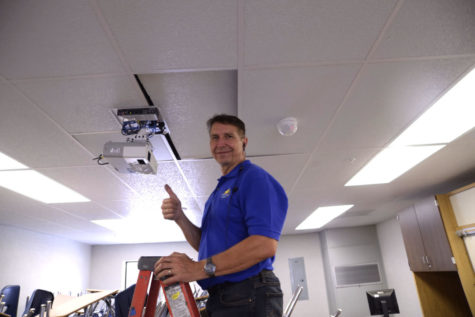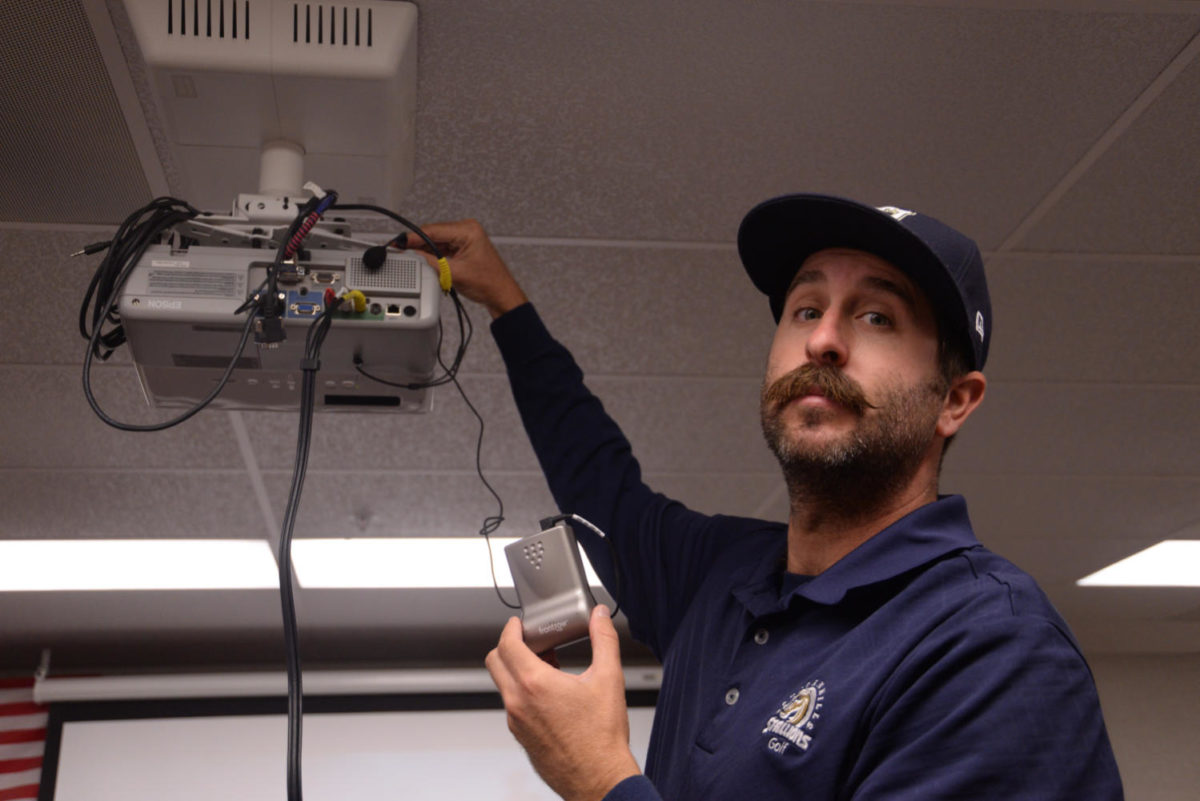Projector Problems Strike School Classrooms
Frustrations ease as problems slowly become resolved.
Mr. Roberts explains his improvised audio setup during U.S. history. Without a working audio connection he used a wireless microphone held up to the small speaker behind the projector to boost the sound to the classroom. The idea was suggested by Mr. Hernandez. Many classrooms in the school, and especially the H building have faulty AV equipment, which prevents teachers from projecting presentations or adding video content to lessons.
October 16, 2017
Every school has a little trouble getting back on its feet after the summer break. This time, the technology gave the teaching staff a particularly hard time with non-functional projectors in many classrooms.
While lots of attention focused on getting the new J Building ready for the school year, problems with existing equipment in other areas on campus took longer to resolve.
Broken projectors, loss of audio, and white boxes that would not turn on were disrupting the flow of classroom lessons and leaving teachers to improvise their own solutions.
Nine out of the 22 classrooms in the H building, seven classrooms in the E building, and four spread around other buildings were in some way affected with equipment failures. The installations were provided by Lake Forest-based company Digital Networks when the buildings were equipped in 2007 or when the H building was added in 2008-2009.
One of the teachers affected with AV problems, Nate Roberts, used his ingenuity by piecing together an improvised audio rig in order for his class to hear the videos he was playing,
Mr. Roberts is just one of the ten teachers with similar problems in the H building. Not only do these problems create extra work for teachers to work around their setbacks, but it prevents the students from learning through video or audio segments.
Previously it was believed that CUSD had to use the original vendor, Digital Networks, to fix these issues and they were very expensive and they billed a lot of hours for small amounts of work, according to Veres.
Darrin Jindra, Assistant Principal, said CUSD was under the assumption that if any outside vendors were hired to fix the problems that they would be void the warranty with Digital Networks.
After realizing that bringing in someone to help with the problem other than Digital Networks, Kory Veres, from CUSD Maintenance and Operations, was invited to see how bad it really is.
Jindra said that after they receive a “diagnosis” of the problem from Veres, the district will be able to make the decision of whether to upgrade or not.
“I am taking some parts from rooms that have multiple issues, and fixing those other ones. It’s like robbing Peter to pay Paul. I am very cautious to keep everything that is working in place,” he said.
“It was discussed to upgrade everything and that might also be a possibility.” Kory said. This is due to the fact that after the school spends the money to fix all of the projector problems the cost might be even higher than if we go the new upgraded versions. There are pros and cons to upgrading though.
Veres went on to say that our projector system is a bit tougher to deal with “because we are on VGA (a type of data connection) and right now pretty much everybody wants to use HDMI. It’s much easier. Most newer laptops don’t have VGA.”
Although it would be more convenient for us to make the switch to the upgraded equipment, at the same time we should be grateful for what we have. Veres went on to say, “It feels kind of awkward to upgrade after six years. I’m still working at some schools with systems thirty to forty years old.”

Whether we upgrade or not, the technologies we use in classrooms today, “are very much needed for education,” he said.
With almost half of the classrooms in the H building affected, as well as others on campus, the school is very much aware of the problem and is sending hardworking men like Kory to fix the problem.



